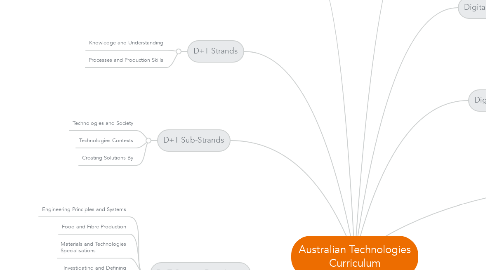
1. Cross-curriculum Priorities
1.1. Aboriginal and Torress Strait Islander Histories and Cultures
1.2. Asia and Australia's Engagement with Asia
1.3. Sustainability
2. Subjects
2.1. Design and Technologies
2.2. Digital Technologies
3. D+T Strands
3.1. Knowledge and Understanding
3.2. Processes and Production Skills
4. Student Diversity
4.1. Students with Disability
4.2. English as an Additional Language or Dialect
4.3. Gifted and Talented Students
5. D+T Content Descriptors
5.1. Engineering Principles and Systems
5.2. Food and Fibre Production
5.3. Materials and Technologies Specialisations
5.4. Investigating and Defining
5.5. Designing
5.6. Producing and Implementing
5.7. Evaluating
5.8. Collaborating and Managing
6. D+T Sub-Strands
6.1. Technologies and Society
6.2. Technologies Contexts
6.3. Creating Solutions By
7. General Capabilities
7.1. Literacy
7.2. Numeracy
7.3. Information and Communication Technology (ICT)
7.4. Critical and Creative Thinking
7.5. Personal and Social
7.6. Ethical Understanding
7.7. Intercultural Understanding
8. Aim and Objectives
8.1. D+T
8.1.1. produce design solutions for differing contexts
8.1.2. understand roles and responsibilities of people in relevant occupations
8.2. Digital
8.2.1. use computational thinking and key abstraction concepts
8.2.2. use digital systems to transform data and communicate creatively
8.2.3. apply thinking to monitor, analyse, predict and shape interactions and understand the impact of these systems
9. Key Ideas
9.1. Overview= Society requires individuals who can apply their understanding of technology to develop solutions to complex challenges and contribute to sustainable living
9.1.1. D+T
9.1.1.1. Technologies are ana essential problem-solving toolset in our knowledge-based society
9.1.1.2. Students develop skills in managing projects, independently and collaboratively, from conception to realisation
9.1.2. Digital
9.1.2.1. Student need to be provided with practical ways to use design and technological thinking strategies to be creative and discerning decision-makers
9.1.2.2. Technologies allow students to become innovative creators of digital solutions, users of digital systems and critical consumers of digital information
